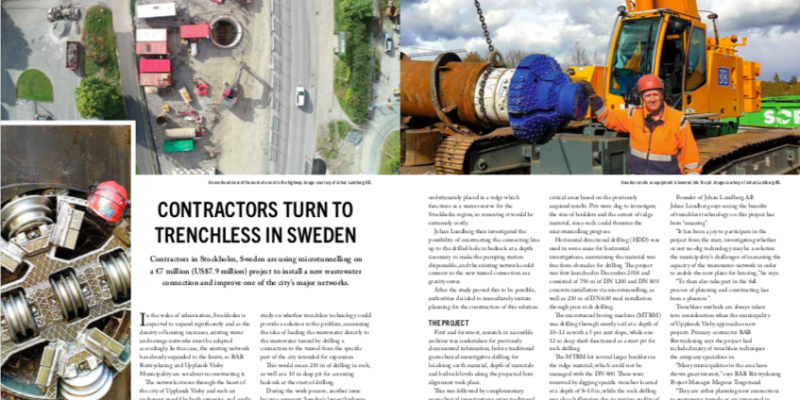Contractors turn to trenchless in Sweden
Publicerad: 7 augusti, 2020

Artikeln i Trenchless International Summer 2020.
Contractors in Stockholm, Sweden are using microtunnelling on a €7 million (US $7.9 million) project to install a new wastewater connection and improve one of the city’s major networks.
In the wake of urbanisation, Stockholm is expected to expand significantly and as the density of housing increases, existing water and sewage networks must be adapted accordingly. In this case, the existing network has already expanded to the limits, so BAB Rörtryckning and Upplands Väsby Municipality are set about reconstructing it.
The network crosses through the heart of the city of Upplands Väsby and such an endeavour would be both extensive and costly, with all wastewater in the area leading to a blasted tunnel 30 m underground.
Housing expansion plans made by the municipality were hindered since no feasible solution could be found regarding wastewater. Johan Lundberg AB conducted a pre-work study on whether trenchless technology could provide a solution to the problem, examining the idea of leading the wastewater directly to the wastewater tunnel by drilling a connection to the tunnel from the specific part of the city intended for expansion.
This would mean 230 m of drilling in rock, as well as a 10 m deep pit for accessing bedrock at the start of drilling.
During the work process, another issue became apparent: Sweden’s largest highway, E4, passes though the municipality, and there were also plans underway for expansions on the other side of the highway in the future.
The highway is in a valley where a pumping station for the existing wastewater network is located, and the station is also
unfortunately placed in a ridge which functions as a water reserve for the Stockholm region, so removing it would be extremely costly.
Johan Lundberg then investigated the possibility of constructing the connecting line up to the drilled hole in bedrock at a depth necessary to make the pumping station dispensable, and the existing network could connect to the new tunnel connection as a gravity sewer.
After the study proved this to be possible, authorities decided to immediately initiate planning for the construction of this solution.
THE PROJECT
First and foremost, research in accessible archives was undertaken for previously documented information, before traditional geotechnical investigative drilling for localising earth material, depth of materials and bedrock levels along the projected bore alignment took place.
This was followed by complementary geotechnical investigations using traditional technology for further understanding of
critical areas based on the previously acquired results. Pits were dug to investigate the size of boulders and the extent of ridge material, since such could threaten the microtunnelling progress.
Horizontal directional drilling (HDD) was used in some areas for horizontal investigations, ascertaining the material was free from obstacles for drilling. The project was first launched in December 2018 and consisted of 750 m of DN 1200 and DN 800 concrete installation via microtunnelling, as well as 230 m of DN 600 steel installation through pure rock drilling.
The microtunnel boring machine (MTBM) was drilling through mostly soil at a depth of 10–12 m with a 5 per cent slope, while one 12 m deep shaft functioned as a start pit for rock drilling.
The MTBM hit several larger boulders in the ridge material, which could not be managed with the DN 800. These were removed by digging specific trenches located at a depth of 8–10 m, while the rock drilling was also challenging due to varying quality of the rock material along the bore alignment.
Founder of Johan Lundberg AB Johan Lundberg says seeing the benefits of trenchless technology on this project has been “amazing”.
“It has been a joy to participate in the project from the start, investigating whether or not no-dig technology may be a solution the municipality’s challenges of increasing the capacity of the wastewater-network in order to enable the new plans for housing,” he says.
“To then also take part in the full process of planning and constructing has been a pleasure.”
Trenchless methods are always taken into consideration when the municipality of Upplands Väsby approaches new projects. Primary contractor BAB Rörtryckning says the project had included many of trenchless techniques the company specialises in.
“Many municipalities in the area have shown great interest,” says BAB Rörtryckning Project Manager Magnus Tingstrand.
“They are either planning new connections to wastewater tunnels or are interested in conducting projects in collaboration.”
FOTNOT: Denna artikel publicerades i Trenchless International Summer 2020.